Biology:Haloacid dehydrogenase superfamily
From HandWiki
| Hydrolase_3 | |||||||||
|---|---|---|---|---|---|---|---|---|---|
 crystal structure of had-like phosphatase yida from e. coli | |||||||||
| Identifiers | |||||||||
| Symbol | Hydrolase_3 | ||||||||
| Pfam | PF08282 | ||||||||
| Pfam clan | CL0137 | ||||||||
| InterPro | IPR013200 | ||||||||
| |||||||||
The haloacid dehydrogenase superfamily (HAD superfamily) is a superfamily of enzymes that include phosphatases, phosphonatases, P-type ATPases, beta-phosphoglucomutases, phosphomannomutases, and dehalogenases, and are involved in a variety of cellular processes ranging from amino acid biosynthesis to detoxification.[1]
Examples
A HAD domain is found in several distinct proteins including:
- Phospholipid-translocating ATPase EC 3.6.3.1, a putative lipid-flipping enzyme involved in cold tolerance in Arabidopsis [2]
- 3-deoxy-D-manno-octulosonate (KDO) 8-phosphate phosphatase (EC 3.1.3.45), which catalyses the final step in the biosynthesis of KDO - a component of lipopolysaccharide in Gram-negative bacteria[3]
- Mannosyl-3-phosphoglycerate phosphatase (EC 3.1.3.70), which hydrolyses mannosyl-3-phosphoglycerate to form the osmolyte mannosylglycerate[4]
- Phosphoglycolate phosphatase (EC 3.1.3.18), which catalyses the dephosphorylation of 2-phosphoglycolate[5]
- 5´-Nucleotidase (EC 3.1.3.5) which either catalyzes the hydrolysis of IMP. or IMP and GMP
- Hypothetical proteins
Human genes encoding proteins that contain this domain include:
References
- ↑ "Computer analysis of bacterial haloacid dehalogenases defines a large superfamily of hydrolases with diverse specificity. Application of an iterative approach to database search". Journal of Molecular Biology 244 (1): 125–32. November 1994. doi:10.1006/jmbi.1994.1711. PMID 7966317. https://zenodo.org/record/1229874.
- ↑ "Chilling tolerance in Arabidopsis involves ALA1, a member of a new family of putative aminophospholipid translocases". The Plant Cell 12 (12): 2441–2454. December 2000. doi:10.2307/3871240. PMID 11148289.
- ↑ "Escherichia coli YrbI is 3-deoxy-D-manno-octulosonate 8-phosphate phosphatase". The Journal of Biological Chemistry 278 (20): 18117–23. May 2003. doi:10.1074/jbc.M301983200. PMID 12639950.
- ↑ "Pathway for the synthesis of mannosylglycerate in the hyperthermophilic archaeon Pyrococcus horikoshii. Biochemical and genetic characterization of key enzymes". The Journal of Biological Chemistry 276 (47): 43580–8. November 2001. doi:10.1074/jbc.M108054200. PMID 11562374.
- ↑ "Structure- and function-based characterization of a new phosphoglycolate phosphatase from Thermoplasma acidophilum". The Journal of Biological Chemistry 279 (1): 517–26. January 2004. doi:10.1074/jbc.M306054200. PMID 14555659.
 |

